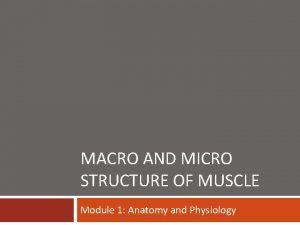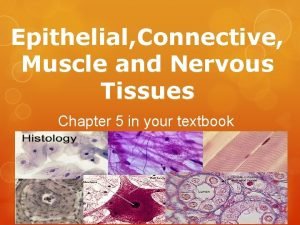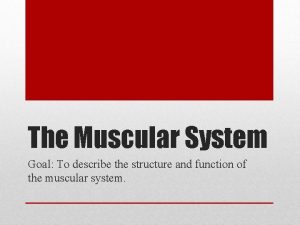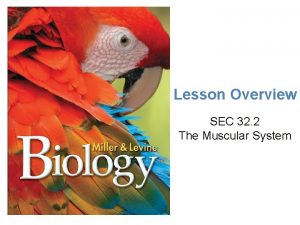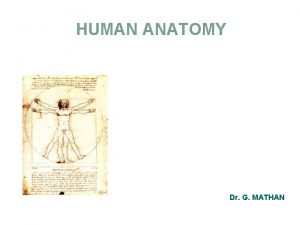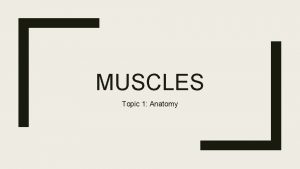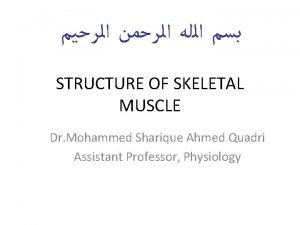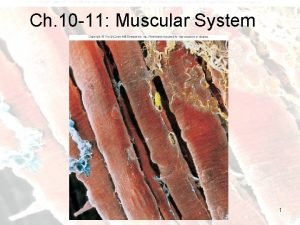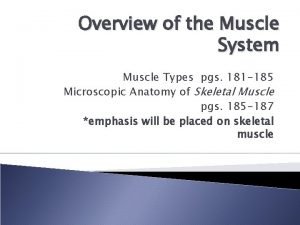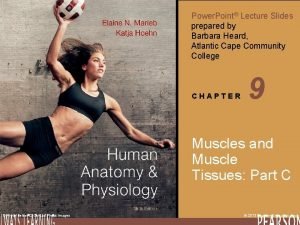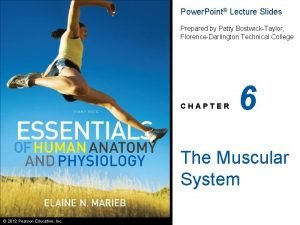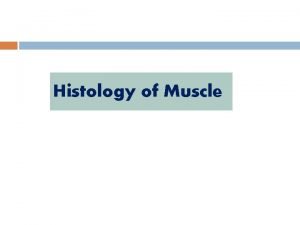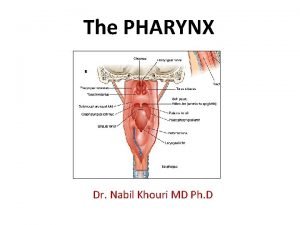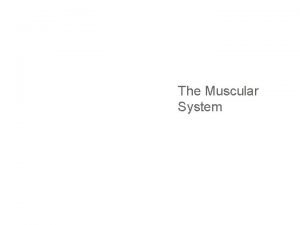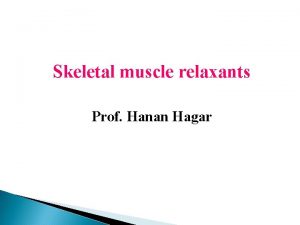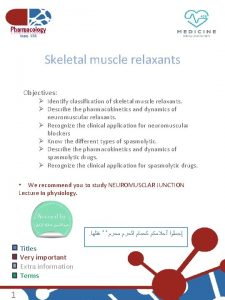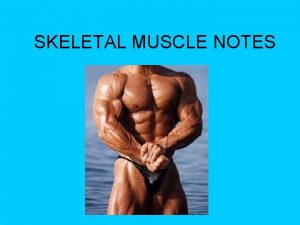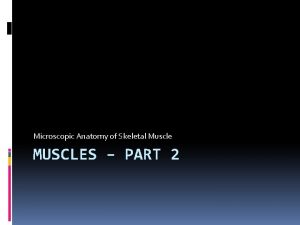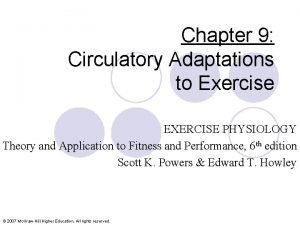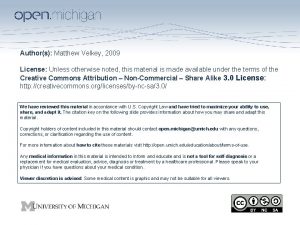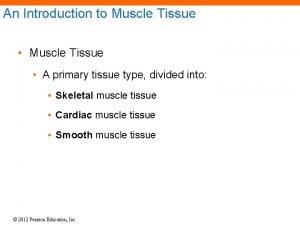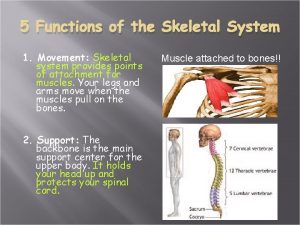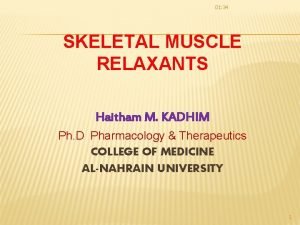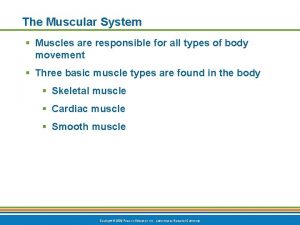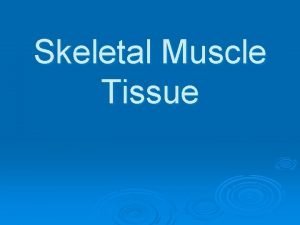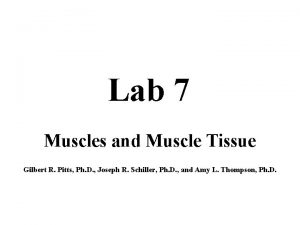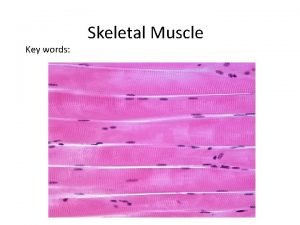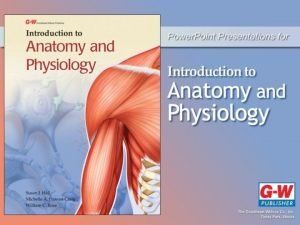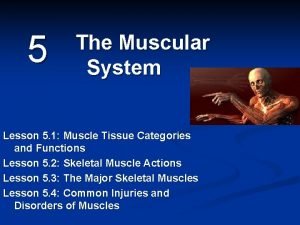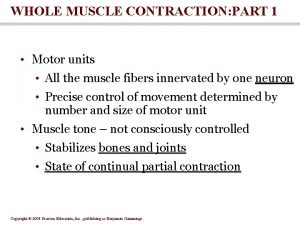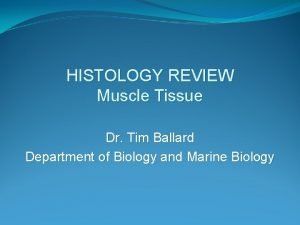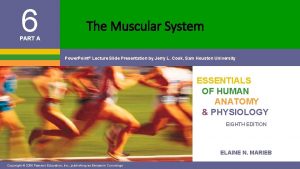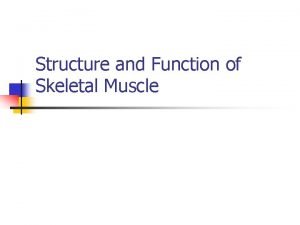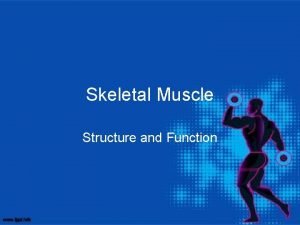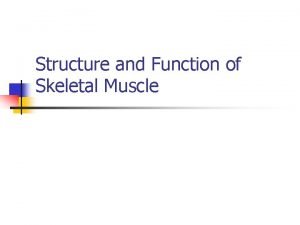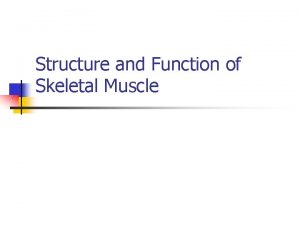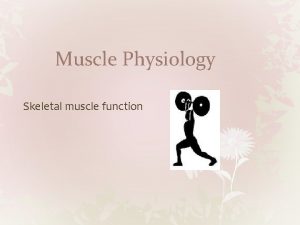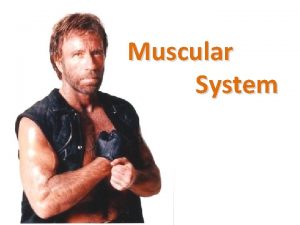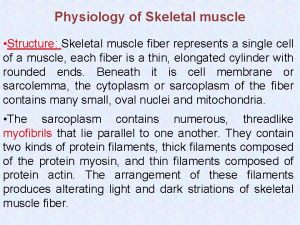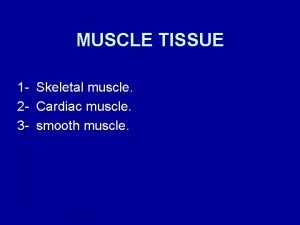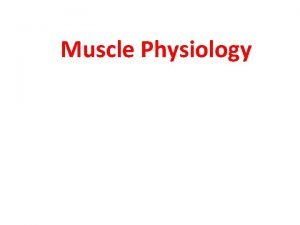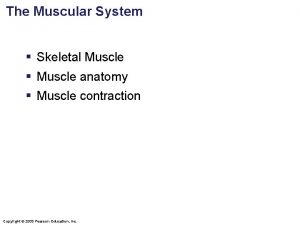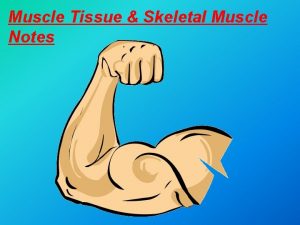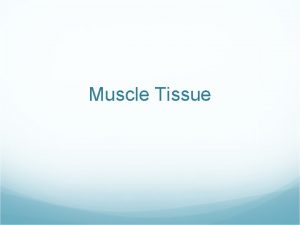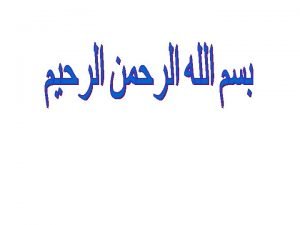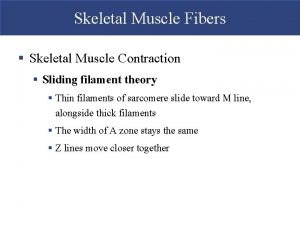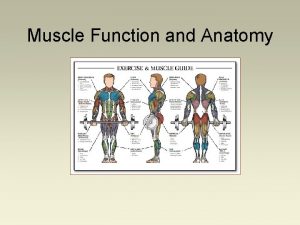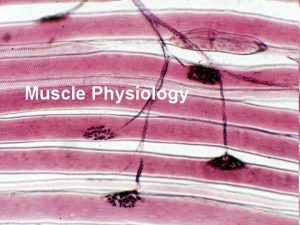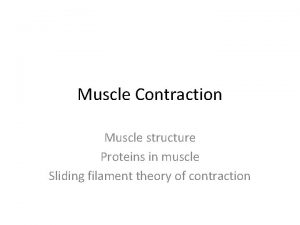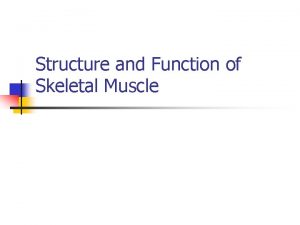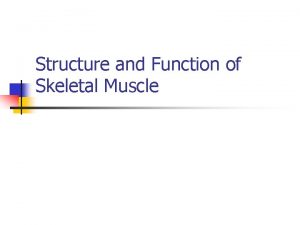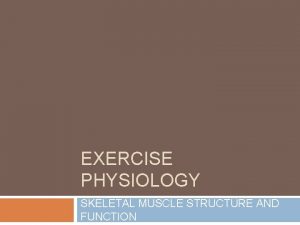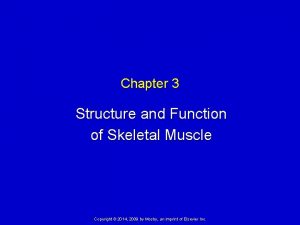Structure and Function of Skeletal Muscle Skeletal Muscle











































- Slides: 43

Structure and Function of Skeletal Muscle

Skeletal Muscle § Human body contains over 400 skeletal muscles – 40 -50% of total body weight § Functions of skeletal muscle – Force production for locomotion and breathing – Force production for postural support – Heat production during cold stress

Movement and breathing § How do our muscles help us breath? § https: //www. youtube. com/watch? v=O 3 n. LJg RO-d 8 § Internal pressure is changed when the ribs and cavity expand.

Postural Support § Postural muscles are constantly contracting and relaxing different fibers so that you can stay upright.

Heat production § Muscles are the main site of energy use. § When we become too cold we shiver – This is because muscle action uses energy and that energy creates heat. – That is why our body naturally reacts to shiver when we are cold.


Structure of Skeletal Muscle: Connective Tissue Covering § Facia – Outer layer that hold muscles down § Epimysium – Surrounds entire muscle § Perimysium – Surrounds bundles of muscle fibers § Fascicles § Endomysium – Surrounds individual muscle fibers

Structure of Skeletal Muscle: Microstructure § Sarcolemma – Muscle cell membrane § Myofibrils – Threadlike strands within muscle fibers – Actin (thin filament) – Myosin (thick filament)


Structure of Skeletal Muscle: The Sarcomere § Further divisions of myofibrils – Z-line § (Divider for each Actin/Myosin Group) – A-band § (Active area where actin and Myosin reside) – I-band § (In-between area which gets smaller as muscles contract and larger as they relax)

See Video on Breakdown of muscle anatomy § Chap 8 b § Now we will look at the Sarcomere Subunit and how muscle contractions happen.

Muscles Packet 1. Insertion: the moveable bone § Bicep insertion is the radius 2. Origin: the stationary bone § bicep originates in two different places in scapula


Muscular Contraction § The sliding filament model – Muscle shortening occurs due to the movement of the actin filament over the myosin filament – Formation of cross-bridges between actin and myosin filaments – Reduction in the distance between Z-lines of the sarcomere

The Sliding Filament Model of Muscle Contraction


Cross-Bridge Formation in Muscle Contraction

Sliding Filament Theory § Rest – uncharged ATP cross-bridge complex § Excitation-coupling – charged ATP cross-bridge complex, “turned on” § Contraction – actomyosin – ATP > ADP & Pi + energy § Recharging – reload cross-bridge with ATP § Relaxation – cross-bridges “turned off”

See Video on Sliding Filament theory in motion § Chap 8 a

Muscle Function § All or none law – fiber contracts completely or not at all § Muscle strength gradation – Multiple motor unit summation – more motor units per unit of time – Wave summation – vary frequency of contraction of individual motor units

Motor Unit § Single motor neuron & muscle fibers it innervates § Eye muscles – 1: 1 muscle/nerve ratio § Hamstrings – 300: 1 muscle/nerve ratio

Illustration of the Neuromuscular Junction

Individual Fiber Types Fast fibers § Type IIb fibers – Fast-twitch fibers – Fast-glycolytic fibers § Type IIa fibers – Intermediate fibers – Fast-oxidative glycolytic fibers Slow fibers § Type I fibers – Slow-twitch fibers – Slow-oxidative fibers

Staining of Fiber Type



Comparison of Maximal Shortening Velocities Between Fiber Types

Fiber Types and Performance § Power athletes – Sprinters – Possess high percentage of fast fibers § Endurance athletes – Distance runners – Have high percentage of slow fibers § Others – Weight lifters and nonathletes – Have about 50% slow and 50% fast fibers


Alteration of Fiber Type by Training § Endurance and resistance training – Cannot change fast fibers to slow fibers – Can result in shift from Type IIb to IIa fibers § Toward more oxidative properties

Training-Induced Changes in Muscle Fiber Type

Hypertrophy and Hyperplasia § Increase in size § Increase in number

Age-Related Changes in Skeletal Muscle § Aging is associated with a loss of muscle mass – Rate increases after 50 years of age § Regular exercise training can improve strength and endurance – Cannot completely eliminate the age-related loss in muscle mass

Age-Related Changes in Skeletal Muscle § Aging is associated with a loss of muscle mass – Rate increases after 50 years of age § Regular exercise training can improve strength and endurance – Cannot completely eliminate the age-related loss in muscle mass

Types of Muscle Contraction § Isometric – – – Muscle exerts force without changing length Pulling against immovable object Postural muscles § Isotonic (dynamic) – Concentric § Muscle shortens during force production – Eccentric § Muscle produces force but length increases

Isotonic and Isometric Contractions

Illustration of a Simple Twitch

Force Regulation in Muscle § Types and number of motor units recruited – More motor units = greater force – Fast motor units = greater force § Initial muscle length – “Ideal” length force generation § Nature of the motor units neural stimulation – Frequency of stimulation § Simple twitch, summation, and tetanus

Relationship Between Stimulus Frequency and Force Generation

Simple Twitch, Summation, and Tetanus

Receptors in Muscle § Muscle spindle – Detect dynamic and static changes in muscle length – Stretch reflex § Stretch on muscle causes reflex contraction § Golgi tendon organ (GTO) – Monitor tension developed in muscle – Prevents damage during excessive force generation § Stimulation results in reflex relaxation of muscle

Muscle Spindle

Golgi Tendon Organ
 Gap junction in smooth muscle
Gap junction in smooth muscle Macro and micro structure of the skeletal muscle
Macro and micro structure of the skeletal muscle Upper leg muscles
Upper leg muscles Function of skeletal muscle
Function of skeletal muscle 5 function of muscular system
5 function of muscular system Function of skeletal muscle
Function of skeletal muscle Evert foot
Evert foot Function of skeletal muscle
Function of skeletal muscle Structure of skeletal muscle
Structure of skeletal muscle T tubules
T tubules Skeletal muscle tissue structure
Skeletal muscle tissue structure Comparison of skeletal cardiac and smooth muscle
Comparison of skeletal cardiac and smooth muscle Characteristics of skeletal smooth and cardiac muscle
Characteristics of skeletal smooth and cardiac muscle Slide
Slide Comparison of skeletal cardiac and smooth muscle
Comparison of skeletal cardiac and smooth muscle Characteristics of skeletal smooth and cardiac muscle
Characteristics of skeletal smooth and cardiac muscle Cardiac muscle tissue
Cardiac muscle tissue Pharynx smooth muscle
Pharynx smooth muscle 5 golden rules of skeletal muscle
5 golden rules of skeletal muscle Centrally acting skeletal muscle relaxants
Centrally acting skeletal muscle relaxants Skeletal muscle relaxants classification
Skeletal muscle relaxants classification Muscle relaxant classification
Muscle relaxant classification Chlorzoxone
Chlorzoxone Skeletal muscle crash course
Skeletal muscle crash course Skeletal muscle relaxants classification
Skeletal muscle relaxants classification Microscopic anatomy of skeletal muscles
Microscopic anatomy of skeletal muscles Muscle fiber organization
Muscle fiber organization Skeletal muscle pump
Skeletal muscle pump Cardiac muscle cross section
Cardiac muscle cross section Titin
Titin Skeletal system 5 functions
Skeletal system 5 functions Skeletal muscle relaxants classification
Skeletal muscle relaxants classification Microscopic anatomy of skeletal muscle figure 6-2
Microscopic anatomy of skeletal muscle figure 6-2 Microscopic anatomy of skeletal muscle figure 6-2
Microscopic anatomy of skeletal muscle figure 6-2 Nerve supply to muscles
Nerve supply to muscles Skeletal muscle belly
Skeletal muscle belly Skeletal muscle cylindrical
Skeletal muscle cylindrical Skeletal muscle
Skeletal muscle Lesson 5.1 the organization of a skeletal muscle
Lesson 5.1 the organization of a skeletal muscle Cross bridge myosin head
Cross bridge myosin head Lesson 5.1 the organization of a skeletal muscle
Lesson 5.1 the organization of a skeletal muscle Physiology of muscle contraction
Physiology of muscle contraction Skeletal muscle tissue 40x
Skeletal muscle tissue 40x Microscopic anatomy of skeletal muscle
Microscopic anatomy of skeletal muscle

